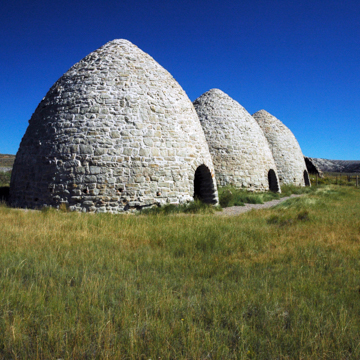Along a remote county road in the southwest corner of Wyoming, three beehive-shaped stone structures rise up out of the prairie—the Piedmont Charcoal Kilns. Built to transform wood into charcoal to be used in iron-ore smelters, the kilns are the only visible reminder of an industry that flourished here starting in 1869 and lasting through the 1870s. More than forty stone kilns once dotted this area, producing per month an estimated 100,000 bushels of charcoal, all of which was shipped by rail to iron-ore smelters in Utah.
Designed to act as huge ovens, the conical-shaped kilns were constructed of local gray limestone. A combination of fieldstones and others that were roughly shaped were laid up in an uncoursed pattern with a lime-sand mortar. Each kiln has a 6 x 5-foot stone-arched entrance facing east. Ventilation was provided through three off-set rows of small air intake holes along the bottom 3 feet of each kiln and a single larger opening on the west side of each kiln near the top. The kilns average about 30 feet in diameter and are approximately 30 feet high at the peak, with 2-foot-thick walls at the base. They stand about 8 feet apart from each other. The interior surfaces are covered with a heavy, hardened layer of carbon. To make charcoal, the kilns were filled to the top with wood and a fire was started. After it caught, the main openings were sealed and the wood smoldered slowly for several days. After this period the drafts were closed, the fire was left to die out, and the wood was allowed to cool before handling.
The charcoal industry in southern Wyoming began in the late 1860s when the Union Pacific Railroad’s transcontinental line pushed through this part of the country. Piedmont was one of many railroad stations established along the line, with a round house, water tank, telegraph office, and a few business establishments. Piedmont’s close proximity to the mines in Utah, combined with the ready availability of timber in the nearby Uinta Mountains, made it an ideal location for charcoal processing and shipping. Although once found in abundance on the frontier, very few of these structures remain undisturbed and unaltered. The Piedmont Kilns tell the important but little-known story of the role of charcoal in early industries in the West and the effort involved in harvesting the wood, loading and firing the kilns, and transporting the charcoal to industrial sites. It was a labor-intensive and environmentally-destructive industry that came to an end when coke became available as a substitute for charcoal in smelters.
Today, three standing kilns and one ruin remain. Nearby Piedmont is a ghost town with a few remnants of houses and other buildings and the 1868 Union Pacific Railroad grade, abandoned in the 1890s, serves as the county road access to the site. The property is owned by the state of Wyoming and is open to the public as a historic site.
References
Abstract Masonry Restoration, Inc. “Recommended Scope of Work and Budgetary Cost Estimate for the Restoration of the Historic Piedmont Charcoal Kilns, Wyoming.” Prepared for Wyoming State Parks and Historic Sites, May 2009.
Barnhart, Bill, “Piedmont Charcoal Kilns,” Uinta County, Wyoming. National Register of Historic Places Inventory – Nomination Form, 1971. National Park Service, U.S. Department of the Interior, Washington, DC.
“Piedmont Charcoal Kilns.” Wyohistory.org. Accessed April 6, 2014. http://www.wyohistory.org/encyclopedia/piedmont-charcoal-kilns.

